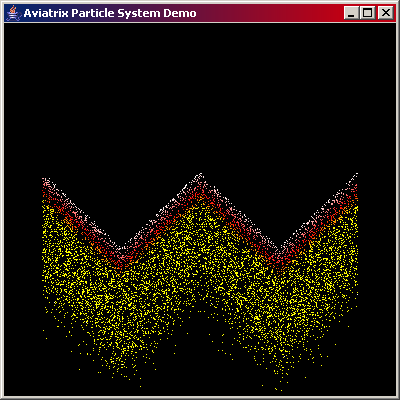
|
Aviatrix3D 2.1.0 |
|||||||||
| PREV PACKAGE NEXT PACKAGE | FRAMES NO FRAMES | |||||||||
See:
Description
| Class Summary | |
|---|---|
| AVParticleSystem | Base particle system implementation for geometry implemented over Aviatrix3D scene graphs. |
| PointParticleSystem | A ParticleSystem implementation that uses points for representing each particle. |
| QuadParticleSystem | A ParticleSystem implementation that uses quads for representing each particle. |
| TriangleFanParticleSystem | A ParticleSystem implementation that uses triangle fans in the shape of a quad for representing each particle. |
Particle systems implemented using the Aviatrix3D scene graph.
Particle systems are used to provide lots of visual effects like smoke and
water in a 3D environment. This generalised system builds on the basic
system provided by org.j3d.geom.particle with code that links it to
Aviatrix3D rendering structures.
org.j3d.geom.particle. There is only a couple of classes
needed per-system from this package. These classes are the implementation of
the particle system manager, and some internal, private implementation classes.
For example, to set up a particle system that uses points for particles and an emitter that is a line, use the following code:
import org.j3d.geom.particle.*;
import org.j3d.renderer.aviatrix3d.geom.particle.PointParticleSystem;
public class MyParticleApp implements ApplicationUpdateObserver { ...
// The particle system manager that we want to clock
private ParticleSystemManager particleSystem;
...
private void setupSceneGraph() {
....
// this will do basic color interpolations over time
float[] time = { 0, 1.5f, 2.5f, 5 };
float[] colors = {
1, 1, 1, 0,
1, 0, 0, 0,
1, 1, 0, 0,
1, 1, 0, 1
};
int particleCount = 10000;
float[] position = {0, -0.5f, -20};
float[] direction = {0, 0, 0};
// create the ParticleInitializer for the ParticleSystem
// the initializer is used to control how long particles within
// the system live and how they are reinitialized when they die.
// this simple initializer lets particles live for 200 iterations
// and moves them to point 0,0,0 when they die
float[] line = { -1, 0, 0,
-0.5f, -0.5f, 0,
0, 0, 0,
0.5f, -0.5f, 0,
1, 0, 0 };
float[] velocity = { 0, -0.1f, 0 };
ParticleInitializer emitter =
new PolylineEmitter(10000,
particleCount,
line,
line.length / 3,
colors,
velocity,
0.25f);
PointParticleSystem smoke_system =
new PointParticleSystem("smoke", particleCount, 4);
smoke_system.setParticleInitializer(emitter);
smoke_system.addParticleFunction(new MaxTimeParticleFunction());
smoke_system.addParticleFunction(new PhysicsFunction());
ColorRampFunction colorRamp = new ColorRampFunction(time, colors, true);
smoke_system.addParticleFunction(colorRamp);
smoke_system.initialize();
particleSystem = new ParticleSystemManager();
particleSystem.addParticleSystem(smoke_system);
// Now create the shape to put the particle system in
Shape3D p_shape = new Shape3D();
p_shape.setGeometry(smoke_system.getNode());
scene_root.addChild(p_shape);
....
}
public void updateSceneGraph() {
particleSystem.update();
}
...
}
And that's it. You should see a raining set of points like this figure:

|
Aviatrix3D 2.1.0 |
|||||||||
| PREV PACKAGE NEXT PACKAGE | FRAMES NO FRAMES | |||||||||